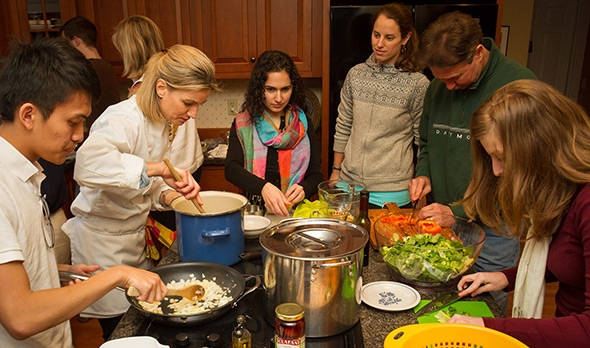Read the full story by Susan Green, published by the Geisel School of Medicine.
“This appetizer is one of my favorites,” says Julia Nordgren, MED ’99, of the goat cheese dip she’s starting to make. “We’ll mix the goat cheese with a bit of Greek yogurt and milk, then add herbs de Provence—smell this, delicious!—and serve it with toasted whole wheat pita chips sprinkled with herbs.”

It’s a cold spring evening and 10 Geisel School of Medicine students, along with Richard Simons, the senior associate dean for medical education, are gathered at Simons’ Vermont home to learn how to cook. Developed by Nordgren, this innovative, elective pilot enrichment class, “The Doctor is IN . . . the Kitchen,” is designed to give students information, skills, and practice in preparing healthy and delicious meals. Each cooking session also explores topics such as celiac disease and gluten-free foods, the Atkins diet, the Mediterranean diet, and vegetarian/vegan foods, along with related recipes.
The philosophy and science behind each of the diets are also discussed. “We consider a variety of issues, such as how the diet works, the research supporting it, and what a meal looks like,” Nordgren adds.
According to Nordgren, many doctors are not equipped to offer their patients solid advice regarding eating, given the plethora of options, and there’s a disconnect between “what we as physicians feed ourselves and how we help our patients feed themselves healthfully in a way that’s neither judgmental nor preachy.”
Passionate about the power of good food, Nordgren on a mission to arm physicians and medical students with the culinary literacy necessary for them to comfortably discuss the relationship between nutrition and health outcomes with their patients.